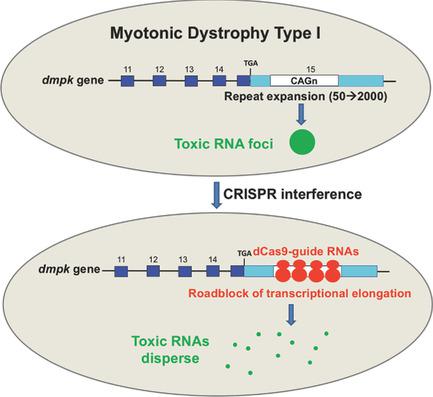当前位置:
X-MOL 学术
›
Small Methods
›
论文详情
Our official English website, www.x-mol.net, welcomes your
feedback! (Note: you will need to create a separate account there.)
A CRISPR‐Based Selective Gene Inhibition Method Reveals Dynamic Features of a Cell Nucleus Nanobody Related to the Disease Myotonic Dystrophy
Small Methods ( IF 10.7 ) Pub Date : 2018-05-17 , DOI: 10.1002/smtd.201700400 Hanhui Ma 1 , Pablo Reyes-Gutierrez 1 , Thoru Pederson 1
Small Methods ( IF 10.7 ) Pub Date : 2018-05-17 , DOI: 10.1002/smtd.201700400 Hanhui Ma 1 , Pablo Reyes-Gutierrez 1 , Thoru Pederson 1
Affiliation

|
A major form of the severe pediatric muscle disease myotonic dystrophy is caused by a CTG repeat expansion in the gene (dmpk) for the enzyme DM protein kinase 1. As a consequence, this mutant allele produces aberrant transcripts that have elongated tracts of CUG repeats. These RNAs appear to stall within the cell nucleus, congressing in small, discrete bodies situated away from their site of gene transcription. Here, clustered regularly interspaced short palindromic repeats (CRISPR)‐based approach is deployed that reveals that these nuclear nanobodies are not static structures. When the transcription of the dmpk gene is halted by a targeted CRISPR‐based inhibition method, the preexisting transcripts delocalize from the nuclear bodies, showing that they are continuously trafficking through and are not stalled there in an accretion mode. This report is an example of how a novel method can address a nanoscale dimension of molecular cell biology in the nucleus, one with direct medical relevance.
中文翻译:

基于CRISPR的选择性基因抑制方法揭示了与疾病强直性营养不良相关的细胞核纳米抗体的动态特征
严重的小儿肌肉疾病肌强直性营养不良的主要形式是由DM蛋白激酶1的基因(dmpk)中的CTG重复扩增引起的。结果,该突变等位基因产生异常的转录本,具有较长的CUG重复序列。这些RNA似乎停滞在细胞核内,聚集在远离基因转录位点的小的离散体中。在这里,采用了基于聚类的规则间隔的短回文重复序列(CRISPR)的方法,该方法揭示了这些核纳米抗体不是静态结构。当dmpk转录时基因通过基于CRISPR的靶向抑制方法被中止,先前存在的转录物从核体中脱位,表明它们一直在不断地运输并且不会以积聚的方式停滞在那里。该报告是一个示例,说明了一种新方法如何解决细胞核中分子细胞生物学的纳米尺度问题,这与医学直接相关。
更新日期:2018-05-17
中文翻译:

基于CRISPR的选择性基因抑制方法揭示了与疾病强直性营养不良相关的细胞核纳米抗体的动态特征
严重的小儿肌肉疾病肌强直性营养不良的主要形式是由DM蛋白激酶1的基因(dmpk)中的CTG重复扩增引起的。结果,该突变等位基因产生异常的转录本,具有较长的CUG重复序列。这些RNA似乎停滞在细胞核内,聚集在远离基因转录位点的小的离散体中。在这里,采用了基于聚类的规则间隔的短回文重复序列(CRISPR)的方法,该方法揭示了这些核纳米抗体不是静态结构。当dmpk转录时基因通过基于CRISPR的靶向抑制方法被中止,先前存在的转录物从核体中脱位,表明它们一直在不断地运输并且不会以积聚的方式停滞在那里。该报告是一个示例,说明了一种新方法如何解决细胞核中分子细胞生物学的纳米尺度问题,这与医学直接相关。











































 京公网安备 11010802027423号
京公网安备 11010802027423号